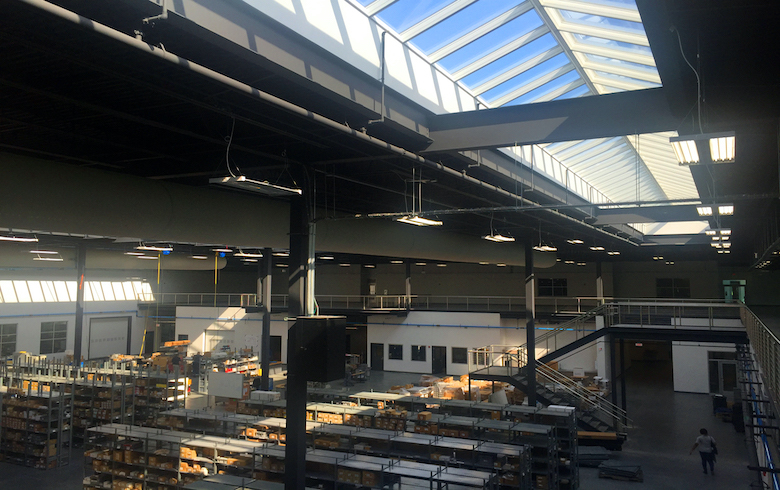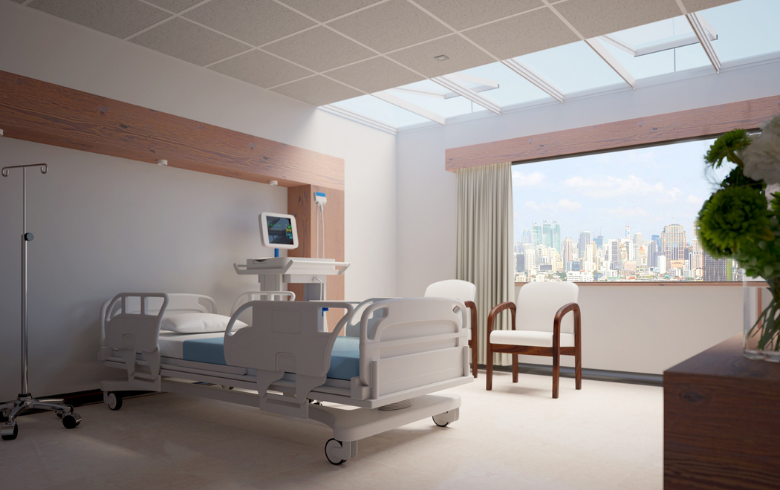Skylights are not a new concept for warehouses and other industrial buildings, but their history in these spaces has long been considered, "nice to have, not need to have." And that's changing.
With significant evidence-based benefits of natural light in industrial spaces becoming more apparent — both in human factors, like wellbeing and workplace efficiency, and also in terms of energy performance — skylights have become more popular in commercial designs than ever before.
Why Install Skylights in Industrial Spaces
When it comes to commercial architecture, industrial buildings are inherently high-risk. These buildings often house heavy machinery, fast-paced production lines, and long working hours, so safety is a key concern from design to construction to implementation. That means proper light levels are essential in these spaces to protect workers and businesses from financial repercussions and liabilities. With limited natural light, workers are less alert and productive, which can be detrimental to worker health and production capabilities. Utilizing natural light through skylights, however, can help combat eye strain and fatigue in workers and the rising energy costs of illuminating such large spaces.
Daylight Benefits for Industrial Spaces
A study conducted by the National Institute of Standards and Technology found that daylighting in industrial spaces can increase business profits, productivity, and employee morale, all while lowering energy bills. Similar research by Cornell University professor, Dr. Alan Hedge, found that natural light improved workers' health and wellness, citing a 51% drop in eyestrain, a 63% drop in headaches, and a 56% reduction in drowsiness.
To achieve these benefits and for optimum efficiency, workspaces and loading docks should have an illuminance level of 150-300 lux. Engineering and mechanical spaces should provide 300-750 lux.
Four Ways to Design with Daylight in Industrial Spaces
- Allow skylights to function as the primary lighting design with electric lighting as a secondary source to ensure workers have ample exposure to daylight.
- Plan skylight locations according to the warehouse configuration. Invest in daylighting solutions that cascade down and illuminate high traffic areas and manufacturing equipment for added safety.
- Utilize glazing technologies to help increase energy efficiency and diffuse daylight to eliminate glare, hot spots, and sharp shadows that may hinder visibility.
- Consider incorporating skylight shades to control the level of daylight and glare on workspaces.
Natural Ventilation Benefits for Industrial Spaces
Fresh air is a necessity when it comes to industrial building design and healthy working conditions. But larger commercial buildings, like industrial warehouses, typically have more complex requirements to control air quality. Therefore, the ventilation rate is often a result of cooling needs rather than the need for fresh air supply to building occupants.
Natural ventilation through skylights can be combined with mechanical ventilation systems to minimize the strain on heating and cooling systems. In industrial spaces with high ceilings, venting skylights and mechanical ventilation work together to create the stack effect, which quickly releases hot, CO2 emissions for cooler, fresher air.
Four Ways to Increase Indoor Air Quality in Industrial Spaces
- Incorporate venting skylights that monitor indoor air quality and release built-up CO2 levels and manufacturing emissions for better indoor air.
- Program venting skylights throughout the day to coincide with employee breaks, busy production or manufacturing times with higher emissions, or after hours for night cooling.
- Give workers control of venting skylights with individual controls that provide on-demand air circulation for a happier, healthier workspace.
- When possible, open façade windows and skylights to control humidity levels and release stale, unhealthy air.
Commercial Skylights & Energy Efficiency
Artificial lighting is one of the largest sources of energy consumption in commercial and industrial spaces, account for nearly 40% of a building's energy expenditure. But with highly visible light transmittance skylights, buildings can become less dependent on artificial lighting sources. With natural light from above, electric lights can be turned off an average of 70-80% of the time. Proper daylighting as been shown to recoup the cost of skylights in fewer than two years. Along with the reduction in electric lighting, this savings can provide long-term energy conservation and overall lower energy costs.
Skylights can also offer energy efficiency and savings when combined with advanced glazing that provide low U-values to reduce thermal transmittance, which helps stabilize building temperatures for superior thermal efficiency.
Four Ways to Boost Energy Efficiency in Industrial Designs
- Incorporate energy-efficient vertical windows, transluscent wall systems, or skylights to provide natural daylight throughout a warehouse to limit the need for artificial lighting.
- Specify energy-efficient mechanical ventilation in skylights to use natural ventilation strategies to cool the building and limit strain on HVAC systems.
- Opt for photovoltaic glass technology to generate power and provide energy by harnessing abundant natural daylight.
- Add shades to skylights to provide daylight and heat control for year-round indoor comfort.
How VELUX Commercial Can Help
From initial concept through assessment and planning, VELUX Commercial Daylighting Experts can help you achieve your design goals, ensuring you have the daylighting resources you need.
- Daylight Rendering Assistance. The VELUX Daylight Visualizer is a simulation tool that analyzes daylight conditions, allowing you to make informed decisions about daylight preformance in your designs. Download the Visualizer.
- Custom Commercial Rendering. The VELUX Design Center provides custom renderings so you can see the effects skylights will have in specific commercial spaces. Request a rendering.
- SkyCalc Assistance. Quickly determine the number of skylights needed to maximize energy savings with SkyCalc and VELUX Design Experts. Begin a SkyCalc.
- Design and Product Data Resources. So you can spend more time designing, VELUX Commercial has all the data and resources you need, from specifying to certifying to installation, available to get the job done. Download data.





.png?width=805&name=get%20the%20commercial%20application%20ebooks%20(1).png)